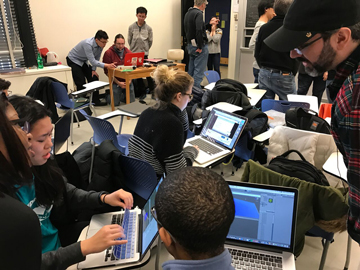Summary
Students form groups of 4–6 where one member volunteers their computer to be show a video tutorial and joins the other members to work through the video tutorial together on the remaining computers. On this page, we describe the purpose and logistics of running this activity.
Purpose

Students in the Unity guided tutorial session. (Courtesy of MIT OpenCourseWare.)
This class was designed to introduce students who had never worked with the Unity game engine to videogame design using the software. Unity has provided an incredible collection of high-quality online tutorials that have very good pedagogy. Since this is a short course, we feel it is important to introduce students to the existence of these tutorials so they can advance their skillset after the class ends. We use the roll-a-ball tutorial for this class since it introduces the basics of the system very well. Students break into groups of 4–6 where one member volunteers their computer to be show a video tutorial and joins the other members to work through the video tutorial together on the remaining computers.
Team Formation
After introducing the basic logistics of the activity, it is important to set expectations for the students to work together at a pace that is suitable for every member of the group. In order to make this a reality, it is important to instruct the students to be very vocal about every question they have, asking the group to pause and discuss the question. Again, remind students that they are here because of the social support, not just to rush through a tutorial. Tell the students that the point of this activity is as much to talk as it is to do. The more students learn to be vulnerable and ask questions, the more they will be able to succeed in the modern collaborative environment. It can be helpful to guide students to form groups with varied experience levels for this activity to increase the chance of having good discussions. Also informing students that they should jump into another group for any reason at any point. If you can model what it looks like to ask a question and answer a question supportively it can also be a very potent technique for ensuring a supportive experience for students. This is an opportunity to learn and to learn to teach.
Tutorial
The tutorial itself will walk the students through the process of creating the following game.
Class Videos
|
|
Guided Tutorial: Introduction to Unity Mark Vrablic provides an overview of the Unity game engine and how to work with the software interface. This is provided to help students get started on an even footing when jumping into the guided tutorial. |
 |
Guided Tutorial: Purpose and Overview Kyle Keane sets expectations for the group dynamics of the guided tutorial, letting students know they should ask each other lots of questions and work as a team to find answers. |

